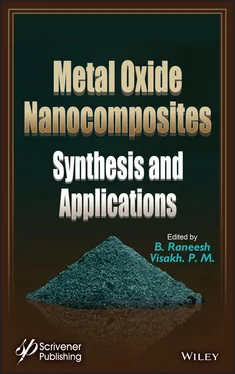Metal Oxide Nanocomposites
Здесь есть возможность читать онлайн «Metal Oxide Nanocomposites» — ознакомительный отрывок электронной книги совершенно бесплатно, а после прочтения отрывка купить полную версию. В некоторых случаях можно слушать аудио, скачать через торрент в формате fb2 и присутствует краткое содержание. Жанр: unrecognised, на английском языке. Описание произведения, (предисловие) а так же отзывы посетителей доступны на портале библиотеки ЛибКат.
- Название:Metal Oxide Nanocomposites
- Автор:
- Жанр:
- Год:неизвестен
- ISBN:нет данных
- Рейтинг книги:5 / 5. Голосов: 1
-
Избранное:Добавить в избранное
- Отзывы:
-
Ваша оценка:
- 100
- 1
- 2
- 3
- 4
- 5
Metal Oxide Nanocomposites: краткое содержание, описание и аннотация
Предлагаем к чтению аннотацию, описание, краткое содержание или предисловие (зависит от того, что написал сам автор книги «Metal Oxide Nanocomposites»). Если вы не нашли необходимую информацию о книге — напишите в комментариях, мы постараемся отыскать её.
Metal Oxide Nanocomposites — читать онлайн ознакомительный отрывок
Ниже представлен текст книги, разбитый по страницам. Система сохранения места последней прочитанной страницы, позволяет с удобством читать онлайн бесплатно книгу «Metal Oxide Nanocomposites», без необходимости каждый раз заново искать на чём Вы остановились. Поставьте закладку, и сможете в любой момент перейти на страницу, на которой закончили чтение.
Интервал:
Закладка:
Metal oxide-based nanocomposites and their many applications are the subject of Chapter 9. It covers their use in the food and agricultural sector and in medicine due to their water barrier, thermal and flame-retardant properties, and their ability to disinfect water and improve water flux. Also discussed are nanocomposite membrane assemblies for water treatment prepared by non-solvent induced phase separation method, their adsorption performances, and their suitability for electrocatalytic, biosensor and sensing applications. Next, in Chapter 10, energy harvesting and sensing applications of triboelectric nanogenerators (TENG) are presented. Among the topics discussed are the working mechanism of a triboelectric nanogenerator, how to select materials for your TENG, basic operating modes of TENG, TENG as mechanical energy harvester, and TENG based on vertical contact separation mode, lateral sliding mode, single electrode mode and free-standing triboelectric layer mode. The final chapter on metal oxide nanocomposites for water purification includes several topics such as adsorptive removal of water pollutants; and the use of metal oxide nanocomposites for photocatalytic decomposition of water pollutants, removal and decomposition of inorganic pollutants, and decomposition of organic pollutants.
In conclusion, we would like to express our sincere gratitude to all the contributors to this book, whose commitment and sincerity shown towards their contributions, along with their enthusiasm and excellent support, enabled the successful completion of this venture. We would also like to thank all the reviewers who have taken their valuable time to make critical comments on each chapter. Finally, our thanks go out to Scrivener Publishing for recognizing the demand for such a book and realizing the increasing importance of the area of metal oxide nanocomposites and their synthesis and applications.
Dr. B. Raneesh Dr. Visakh P. M. November 2020
1
Metal Oxide Nanocomposites: State-of-the-Art and New Challenges
Visakh P.M.1* and B. Raneesh2
1Department of Physical Electronics, TUSUR University, Tomsk, Russia
2Department of Physics, Catholicate College, Pathanamthitta, Kerala, India
Abstract
This first chapter discusses about the metal oxide nanocomposites: synthesis and applications with many different topics such as introduction to nanocomposites, graphene-based metal, metal oxide nanocomposites, carbon nanotube–metal oxide nanocomposites, metal oxide-based nanocomposites application towards photocatalysis, metal oxide nanomaterials for sensor applications, metal oxide nanocomposites and its thermal property analysis, semiconducting metal oxides for photocatalytic and gas sensing applications, and other potential applications of metal oxide-based nanocomposites.
Keywords:Metal oxide nanocomposites, carbon nanotube, graphene, photocatalysis, gas sensor
1.1 Introduction to Nanocomposites
The composite materials composed of polymer matrix are easily processible and readily available and therefore widely used in various industries. In composite materials, the fiber acts as load carrier with its strength being greatest along the axis of the fiber. The long continuous fibers aligned in the direction of the load leads to the formation of composite with much enhanced properties than the pure matrix material. Research studies reveal that the spider’s web fibers are much stronger than man-made processed fibers. In ancient civilizations across the world, husks or straws mixed with clay have been widely utilized to build houses that last longer for several hundred years [1]. The matrix material in composites serves two important purposes: (a) binding the reinforcement phases in place and (b) uniformly distributing the stresses among the constituent reinforcement materials in the event of an applied force. The matrix offer weight advantages and ease of handling. The inorganic materials, polymers and metals can be utilized as matrix materials in the designing of structural composites [2]. Thermoplastics resins are generally used as molding compounds. The fibers are randomly dispersed in thermoplastics, and so the reinforcement is isotropic but directionality can be achieved using molding processes [3]. Thermosets are retained in a partially cured condition over prolonged periods of time to induce flexibility in them [4]. Generally, the condition of fiber material (chopped, aspect ratio) in epoxy, polymer and phenolic polyamide resins decides the final application of thermosets. Most of the metals and alloys can be used as matrices, however, they often require compatible reinforcement materials which are stable over a range of temperature and also non-reactive [5].
The addition of reinforcements in ceramic overcomes the problems related with high modulus of elasticity and low tensile strain to obtain strength improvement. The addition of reinforcements in adequate amount causes the ceramics to effectively transfer quantum of load to the reinforcement thereby reducing the chances of ceramics rupture at high stress levels. The carbon–carbon composite can be synthesized using compaction of carbon or multiple impregnations of porous frames with liquid carbonizer precursors and subsequent pyrolization or through chemical vapor deposition of pyrolytic carbon [6]. In a 2-D composite, the strength remains only one-third to the strength of a unidirectional fiber-stressed in the direction of fibers. But, in a 3-dimension, less than one-fifth of the strength is obtained. The fiber composites can be either continuous or short fibers. It is generally observed that the continuous fibers exhibit better orientation in matrix. The major proportion (>95%) in reinforced plastics are glass fibers. They are inexpensive, have low density, resistant to chemicals, insulation capacity, easy to process with high strength/stiffness than the plastics with which they are reinforced [7]. However, they are more prone to breakage when subjected to high tensile stress for a long time. Metal fibers when amalgamated with refractory ceramics improve performance by improving their thermal shock and impact resistance properties. The resulting composites possess high strength, light weight and good fatigue resistance.
The properties of boron fibers depend upon their diameter due to the changing ratio of boron to tungsten and the associated surface defects that change according to size. The boron fibers are known for their remarkable stiffness and strength [8]. The uncoated boron-tungsten fibers do not react with molten aluminum and also withstand high temperatures for utilization in hot-press titanium matrices. However, silicon carbide-tungsten fibers are dense and prone to surface damage and require careful, delicate handling, during fabrication of the composite [9]. Quartz fibers can withstand high temperatures, while silica cannot [10]. Quartz fibers are highly elastic and can be stretched to 1% of their length before break point. Laminar composites comprises of layers of materials bonded together and can exists in as many combinations as the number of materials. In laminar composites, several layers of two or more metal materials can occur alternately or in a definite order, and in as many numbers as required for a specific purpose. Both clad and sandwich laminates follow the rule of mixtures from the modulus and strength point of view [11]. Flakes composites have densely packed structures. Metal flakes in polymer matrices can conduct electricity or heat, whereas, mica and glass flakes can resist both. Flakes are much cheaper than fibers. More often, the flakes fall short of expectations while controlling the size, shape and hence produce defects in the end product. The infiltrate can be independent of the matrix which binds the components like powders or fibers, or they could just be used to fill voids [12]. The matrix is not naturally formed in the honeycomb structure, but specifically designed to a predetermined shape.
Читать дальшеИнтервал:
Закладка:
Похожие книги на «Metal Oxide Nanocomposites»
Представляем Вашему вниманию похожие книги на «Metal Oxide Nanocomposites» списком для выбора. Мы отобрали схожую по названию и смыслу литературу в надежде предоставить читателям больше вариантов отыскать новые, интересные, ещё непрочитанные произведения.
Обсуждение, отзывы о книге «Metal Oxide Nanocomposites» и просто собственные мнения читателей. Оставьте ваши комментарии, напишите, что Вы думаете о произведении, его смысле или главных героях. Укажите что конкретно понравилось, а что нет, и почему Вы так считаете.












